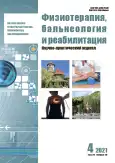Physiotherapy in patients with degenerative-dystrophic diseases of the spine in the presence of vertebral hemangioma
- Authors: Titov A.A.1, Grushina T.I.2
-
Affiliations:
- The Municipal Clinical Hospital named after M.P. Konchalovsky
- Moscow Centre for Research and Practice in Medical Rehabilitation, Restorative and Sports Medicine
- Issue: Vol 20, No 4 (2021)
- Pages: 277-282
- Section: Original studies
- URL: https://bakhtiniada.ru/1681-3456/article/view/107094
- DOI: https://doi.org/10.17816/rjpbr107094
- ID: 107094
Cite item
Abstract
BACKGROUND: In the arsenal of a physiotherapist, there are many methods of non-drug rehabilitation. As contraindications to their use, spinal neoplasms, benign formations with a tendency to growth are indicated, among other things. At the same time, there is no data in the literature on contraindications to physiotherapy in the presence of non-aggressive vertebral hemangioma. As well as there are no scientific studies with a proven absence of a negative effect on the course of this tumor.
AIMS: scientific substantiation of the use of physical methods of treatment of patients with degenerative-dystrophic diseases of the spine in the presence of non-aggressive vertebral hemangioma.
MATERIAL AND METHODS: The study involved 154 patients with degenerative-dystrophic diseases of the spine and non-aggressive vertebral hemangioma. 94 patients were analyzed retrospectively, 60 took part in a prospective study. The following methods of physical therapy were used in the treatment of all patients: magnetotherapy, electrotherapy, physical therapy and massage. All patients underwent computer or magnetic resonance imaging of the spine before the start of treatment and 1 year after the end of treatment with an assessment of the presence or absence of hemangioma growth in dynamics.
RESULTS: In 94 patients with degenerative-dystrophic diseases of the spine in combination with non-aggressive vertebral hemangioma, who received various methods of physiotherapy, a different proportion of cases of increase in the size of vertebral hemangioma was noted upon repeated examination after 1 year. At the same time, in no case did the vertebral hemangioma acquire signs of aggressiveness. The minimum frequency of increasing the size of vertebral hemangioma was noted in patients after magnetic therapy, therapeutic gymnastics and massage. As a result of the use of magnetotherapy, electrotherapy, therapeutic gymnastics and massage in 60 patients, the growth of vertebral hemangioma was detected only in 1 case.
CONCLUSION: In patients with degenerative-dystrophic diseases of the spine, local low-frequency electrotherapy, magnetic therapy, physical therapy and therapeutic back massage did not significantly affect the frequency of cases of increase in the size of vertebral hemangioma. The possibility of using other methods of physiotherapy in the treatment of patients with degenerative-dystrophic processes of the spine in the presence of non-aggressive vertebral hemangioma requires further research.
Full Text
##article.viewOnOriginalSite##About the authors
Alexander A. Titov
The Municipal Clinical Hospital named after M.P. Konchalovsky
Author for correspondence.
Email: titov-al@yandex.ru
ORCID iD: 0000-0002-5866-1739
Russian Federation, Moscow
Tatyana I. Grushina
Moscow Centre for Research and Practice in Medical Rehabilitation, Restorative and Sports Medicine
Email: titov-al@yandex.ru
ORCID iD: 0000-0002-0945-4266
SPIN-code: 5275-6509
MD, Dr. Sci. (Med.), Professor
Russian Federation, MoscowReferences
- Molchanovsky VV, Trinitatsky YuV, Khodarev SV. Non-drug treatment and rehabilitation measures for nonspecific vertebroneurological pathology. Vol. 6. In: V.V. Molchanovsky, Yu.V. Trinitatsky, S.V. Khodarev. Vertebroneurology: monograph. Rostov-on-Don; 2016. 619 p. (In Russ).
- Nikolaev YuA, Polyakov VY, Magomedov MG, Sevostyanova EV. New approaches to the treatment of patients with arterial hypertension with comorbid pathology living in the environmental conditions of the south of Western Siberia. South of Russia: ecology, development. 2021;16(3):119–126. (In Russ). doi: 10.18470/1992-1098-2021-3-119-126
- Sevostyanova EV, Nikolaev YuA, Bogdankevich NV, et al. Combined rehabilitation in the patients presenting with dorsopathies of the lumbar spine and concomitant irritable bowel syndrome based at a therapeutic clinic. Voprosy kurortologii, fizioterapii, i lechebnoi fizicheskoi kultury. 2018;95(2):10–18. (In Russ). doi: 10.17116/kurort201895210-18
- Grushina TI, Titov AA. Modern ideas about vertebral hemangioma. Bulletin of Traumatology and Orthopedics named after N.N. Priorov. 2020;27(1):77–83. (In Russ). doi: 10.17816/vto202027177-83
- Kravtsov MN, Manukovsky VA, Manashchuk VI, Svistov DV. Clinical recommendations "Diagnosis and treatment of aggressive vertebral hemangiomas". Moscow: Association of Neurosurgeons of Russia; 2015. 37 р. (In Russ).
- Eremushkin MA. Classical massage: textbook. Moscow: GEOTAR-Media; 2016. 448 p. (In Russ).
- Petrov KB, Ivonina NA, Mitichkina TV. The main methods of physical exercises in patients with vertebral dorsopathies (lecture). Bulletin of Restorative Medicine. 2020;(1):54–60. (In Russ).
Supplementary files






